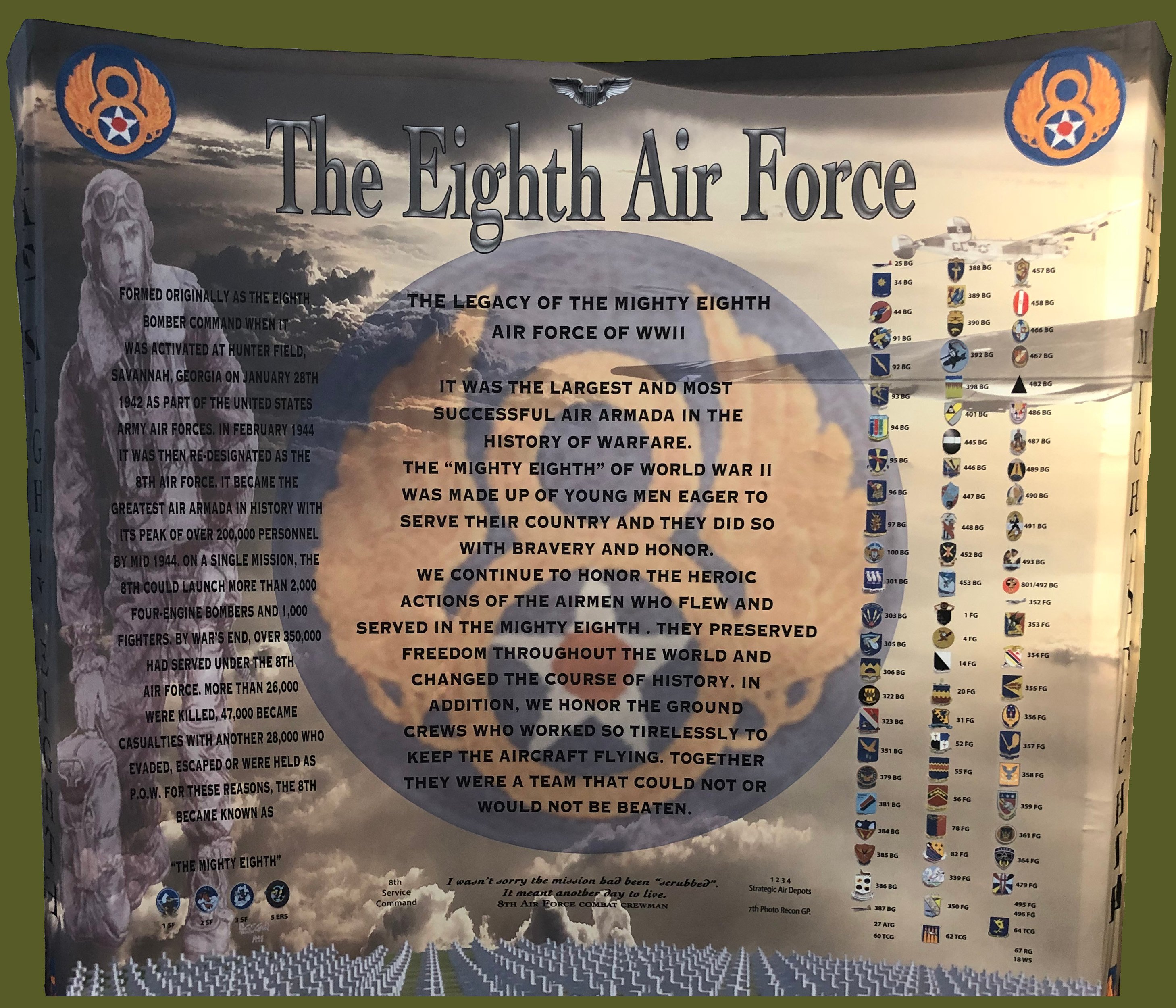
1942
January 1942
Heavy losses gives no choice, the RAF have to reconsider its bombing approach. Closer targets are then attacked.
Unterseeboot – U-boat
Adolf Hitler was intent on starving the British into surrender by sinking the supply ships they so desperately needed. For this, he had the perfect weapon to do it! The Unterseeboot or U-Boat.
After declaring war on the United States, needless to say that Adolf Hitler did not waste one minute in turning his U-boats on American ships.
- In 1939, 114 Merchant Ships were sunk by U-boats
- In 1940, 471 Merchant Ships were sunk by U-boats
- In 1941, 432 Merchant Ships were sunk by U-boats
- By the end of 1942 the number will come to 1,150…!
U-boats could slip underwater, sneak up on unsuspecting merchant ships and destroy them with explosive torpedoes.
In the Atlantic, German U-boats, often navigating as the infamous Wolfpacks, were devastating key Atlantic supply lines. Why the Wolf Pack? Initially a U-boat would brutally attack a defenceless convoy efficiently. The Allies therefore started organizing huge convoys, consisting of up to 200 Merchant ships escorted across the Atlantic Ocean. They were protected by escort carriers and destroyers. When a U-boat attacked a convoy, a destroyer launched explosive underwater depth charges and/or hedgehog bombs in an effort to thwart the submerged submarine. Due to the losses, Adolf Hitler countered the Allies by forming groups of U-boats called Wolfpacks, to wreak havoc on the convoys.
Note: In March 1943, the largest Wolfpack of the war, more than 40 U-boats, attacked two convoys made up of 100 Allied ships. Twenty-one Merchant ships will be sunk.
Shipping losses were reaching dangerous levels, with the Nazis managing to sink Allied vessels on a daily basis. Over a million tons of ships, fuel and equipment went down.
For the Allies it’s a make or break challenge. If they lose this vital lifeline, they could lose the entire war!
British, American, French, Danish and other Allied forces will fight together to win the Battle of the Atlantic. Their ultimate goal, keep the Allied war effort alive with a steady stream of all these much-needed resources: fuel, ammunition, tanks, vehicles, medics, food, soldiers etc.
During this epic struggle, more than 3,000 Allied vessels will be sunk.
Note: The French had three submarines...will be shared in an upcoming blog!
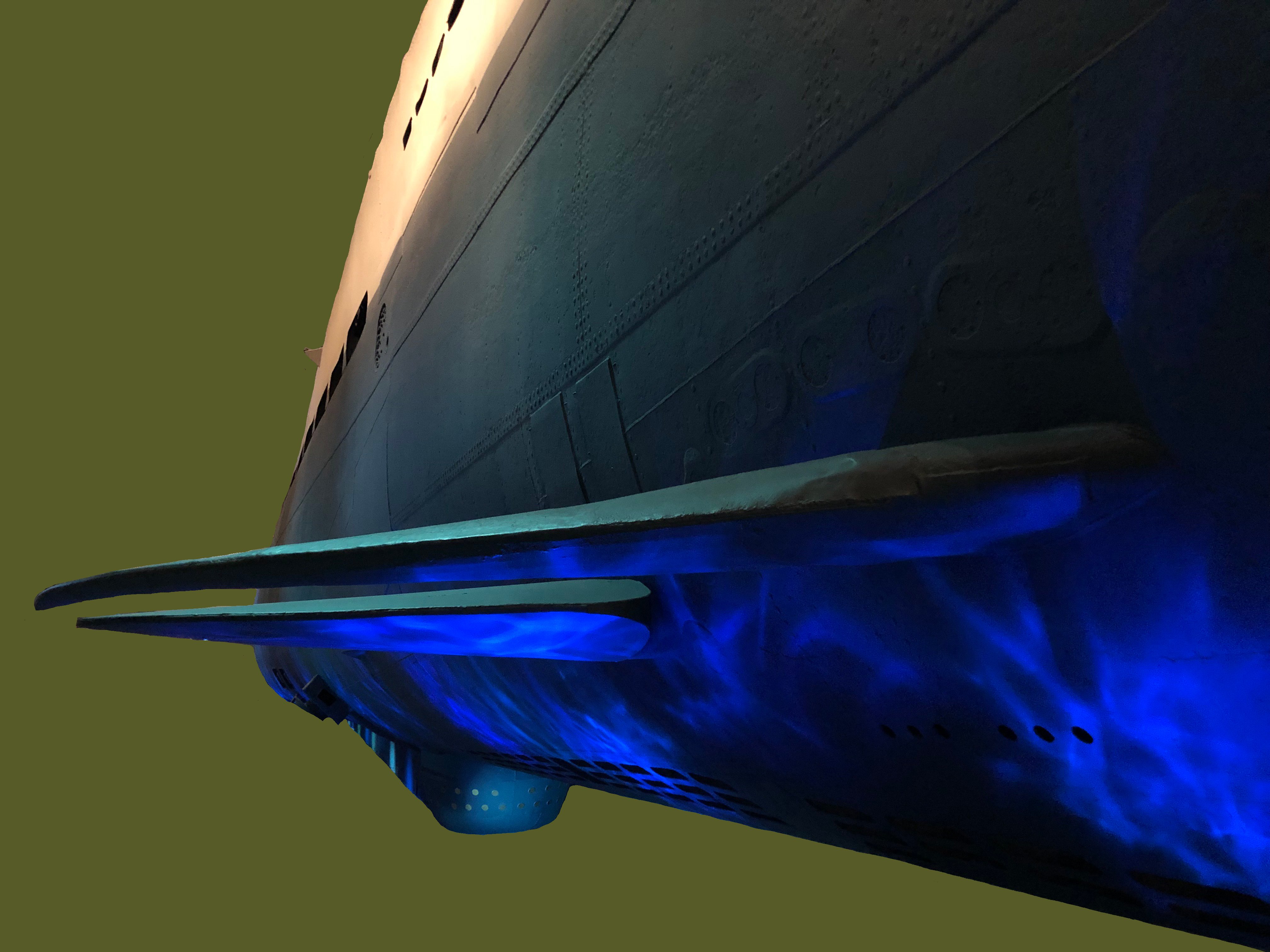
North American P-51K Mustang
The Mustang was a combination of an American aircraft and a British engine: an idea that was first suggested at Duxford, U.K. in 1942.
The P-51 Mustang was one of the three main types of American-built fighters used by the USAAF. Others were the P-47 Thunderbolt and P-38 Lightning.
Mustangs were built for the Royal Air Force, but their performance was disappointing.
Len Thorne, a pilot with the Air Fighting Development Unit (ADFU) at Duxford in 1942, flew the type several times. He and his colleagues recommended that fitting a Mustang with a Rolls-Royce Merlin engine would make “a damned good plane”.
They were right! It became one of the most successful aircraft of WWII with over 8,000 built. Mustangs first went into action in December 1943. Even operating far from their home base, they performed as well as the German fighters sent up to oppose them.
A fighter aircraft had to be able to shoot enemy aircraft in the air. Earlier model P-51s had only four machine-guns mounted on their wings. From May 1944, the P-51D arrived in the U.K. fitted with six 0.50-inch machine-guns, an important increase in firepower!
The racks under the wings were for either two drop tanks (combat range 3,701 km / 2,300 miles) or two 454 kg (1,000 lb.) bombs.
Drop tanks were carried to extend the P-51’s range. The top speed was 703 km (437 mph) at 7,620 meters (25,000 feet) and a cruise speed of 338-515 km (210-320 mph).
Last but not least, earlier model Mustangs had a strutted and upward-hinged cockpit canopy, with a tall fuselage spine which restricted the pilot’s rear view.
From May 1944, the P-51D arrived in the U.K. fitted with a “tear-drop” or “bubble” molded canopy, which provided the pilot a clear, 360° visual.
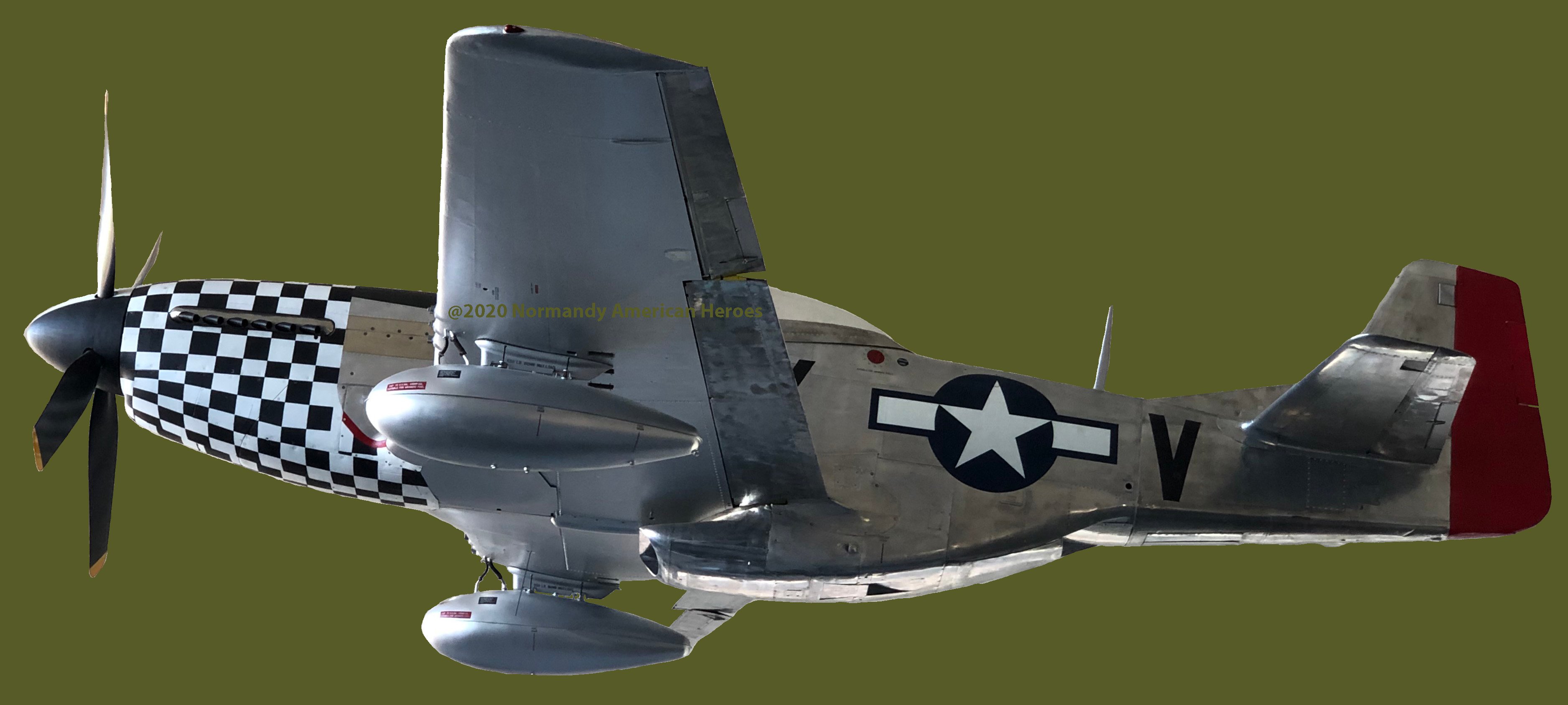
February 1942
Arthur Harris becomes the new Commander-in-Chief of the RAF Bomber Command
General Ira Eaker – USAAF Eighth Air Force
Ira Eaker was one of the senior US military commanders in WWII. His decisions will have a huge impact on the conflict.
The bomber and fighter planes that flew from Britain were just one part of the air war. From 1942 to 1945, the US built up 16 Army Air Forces – over two million men and women – commanded by a few generals!
Commanding an air force was a huge responsibility. Ira Eaker led the Eighth Air Force, which was based in Britain. Then, from January 1944, he commanded several air forces from the US and Britain. They were grouped together as the Mediterranean Allied Air Forces.
One of their jobs was attacking targets on or near the frontline, including bridges, and enemy troops and vehicles. They flew aircraft such as the B-25 Mitchel, to support Allied troops as they fought through Italy and Southern France.
Note: see the blog on Field Marshal Erwin Rommel and the North African battle for the B-25!
The decisions that the generals took will of course have an impact on thousands of lives: their own aircrews and the people working on the ground.
Although none of the American or British commanders wanted to cause unnecessary suffering, most argued that they could not let their personal feelings affect their work. “A military man has to be trained and inured to do the job” said Eaker. “The business of sentiment never enters into it at all”.
Ira Eaker became a pilot in 1918. As a general, he was Eighth Air Force’s first commander. As of February 1942 he faced the difficult task of beginning the bombing campaign against the Third Reich, working with his British allies. Eaker believed that bombing would shorten the war and save lives: “I would be certain that if we had not had strategic bombing… perhaps a million men would have died that lived through that struggle”, he said during an interview after the war.
In January 1944 he moved to take overall command of Allied air power in the Mediterranean. He became Deputy Commanding General of the USAAF in 1945, retiring two years later.
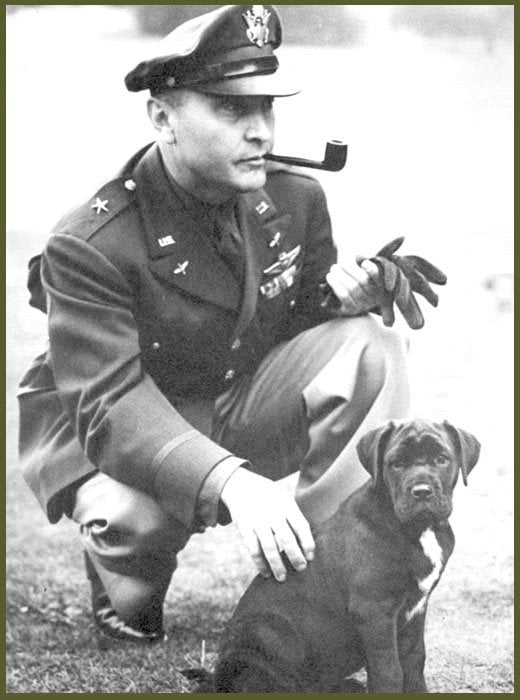
March 1942
German cities became primary targets for area bombing and took place at night, to try as much as possible the crew losses.
The first RAF Bomber Command major success was the bombing of Lübeck on March 28th, 1944 using in the first wave blockbuster bombs followed by incendiaries destroying approximately 62% percent of the city!
It created a firestorm that ravaged the historic center. 25,000 civilians became homeless. The RAF lost almost 6% of its attacking force in that raid.
The Nazi leadership was alarmed at the possible impact of the raid on civilian morale. In the opinion of Joseph Goebbels, the Propaganda Minister, the raid fulfilled the RAF's directive, as he wrote in his diary: "The damage is really enormous, I have been shown a newsreel of the destruction. It is horrible. One can well imagine how such a bombardment affects the population." He commented: "Thank God, it is a North German population, which on the whole is much tougher than the Germans in the south or south-east. We can't get away from the fact that the English air-raids have increased in scope and importance; if they can be continued on these lines, they might conceivably have a demoralizing effect on the population.”
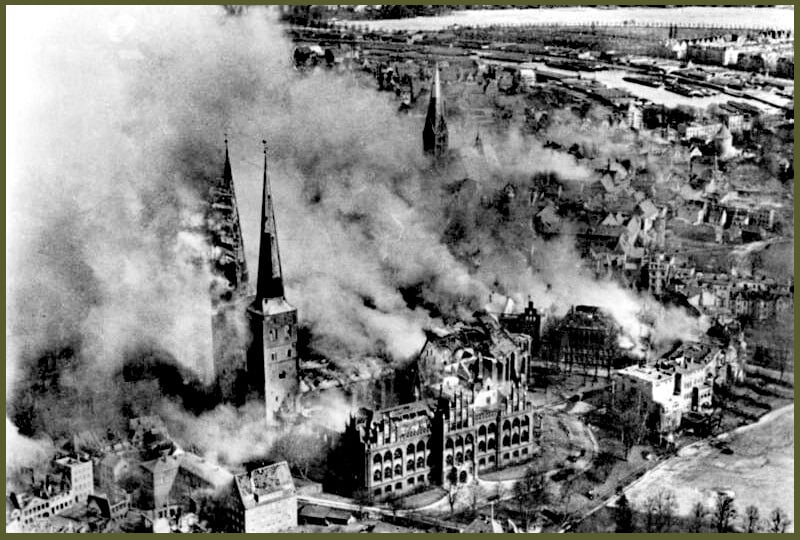
April 1942
The largest Air Force to date (272 aircraft) bombed Hamburg. Meanwhile the Bagotville Air Base in Canada is created with three main objectives:
- Protect the Alcan industrial facilities as the production of Aluminium has a considerable strategic value in the war effort to build planes to defeat the Third Reich;
- Stop the U-boat to penetrate at the mouth of the Saguenay’s river;
- Train wartime pilots as part of the British Commonwealth Air Training Plan
May 1942
May 11th, 1942, the United States Army Air Forces (USAAF) begin to arrive in the United Kingdom.
To support the bomber war, hundreds of airfields are built or taken over by the US Forces. It's important to note that it was the African American troops who did much of the construction.
The USAAF planned to base 17,000 aircraft in Britain to attack Germany!
They needed airfields to operate from. There were already some RAF stations which the USAAF could use, still many more had to be built if the Americans were to mount the huge campaign planned.
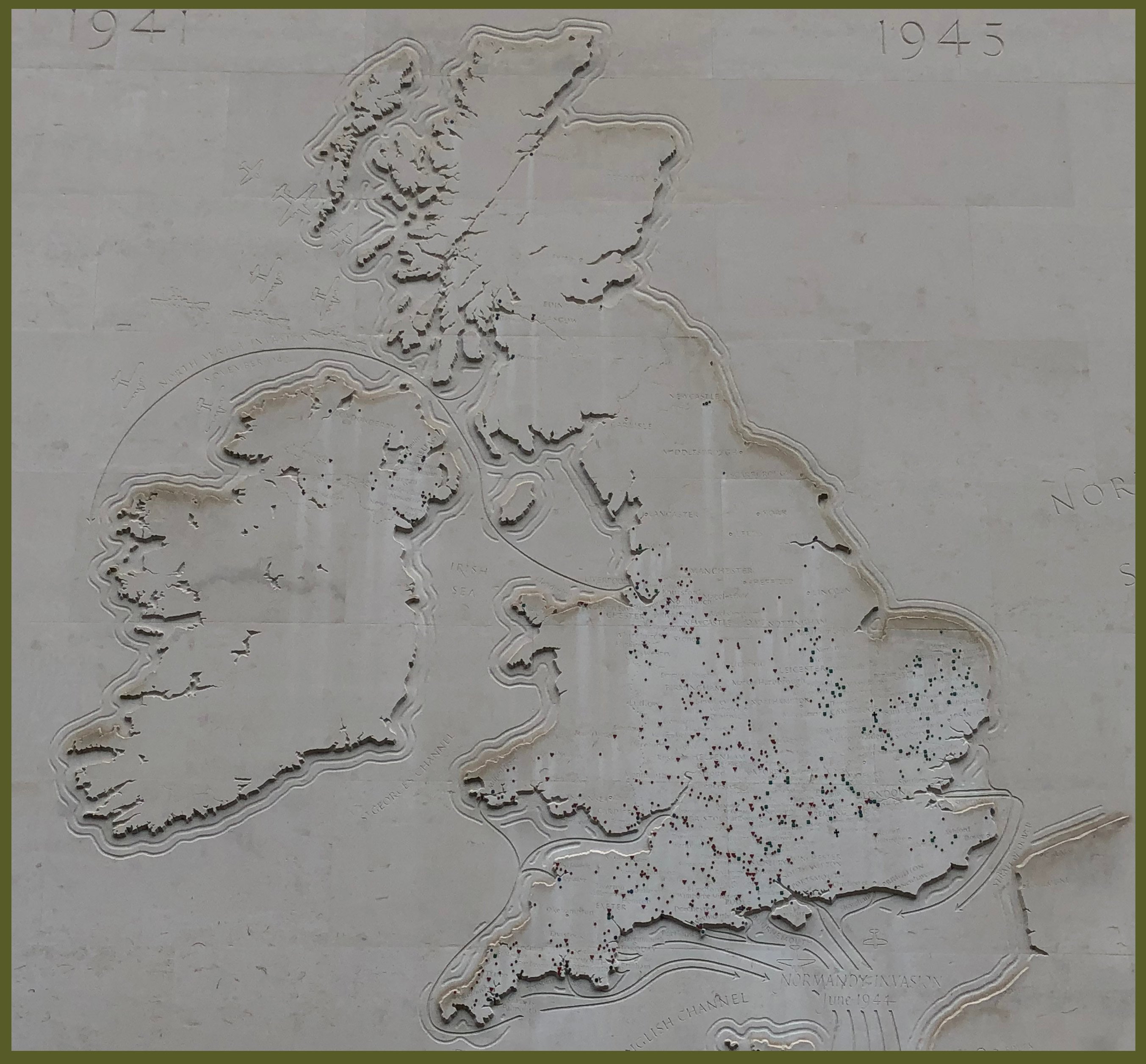
These and many other sites were lent by the people of the United Kingdom to the armed forces of the United States of America in order that they might prepare and support their great military assaults
Boeing B-17G Flying Fortress
The main American bomber of WWII used by the US Eighth Air Force in the bombing offensive against Germany put into practice USAAF doctrine of daylight high altitude precision bombing.
American bombing of Germany was mostly carried out by the US Eighth Air Force based in the United Kingdom where there were over twenty-five Bomb Groups equipped with Fortresses!
They first went into action in France in 1942 and made their first attacks on targets in Germany in January 1943.
The Fortress had a crew of 10 with thirteen 0.5 inch Browning machine guns, carried the heaviest defensive armament of any bomber, a normal bomb load of 2,724 kg and undertook daylight bombing raids in massive close formations which, it was thought, would be capable of defending themselves against German fighter attack without fighter cover. Their top speed was 486 km (302 mph) with a range of 5,470 km (3,400 miles).
However, by mid-1943, on daylight raids deep into Germany, the Eighth Air Force was losing so many aircraft to German fighters that the Americans were forced to reduce their offensive.
It won't be until the introduction of the P51 Mustang, which, with long-range fuel tanks could escort the bombers all the way to their targets, that the American bombing offensive achieved its decisive contribution to the destruction of the Third Reich.
Over 12,600 Fortresses were produced in all.
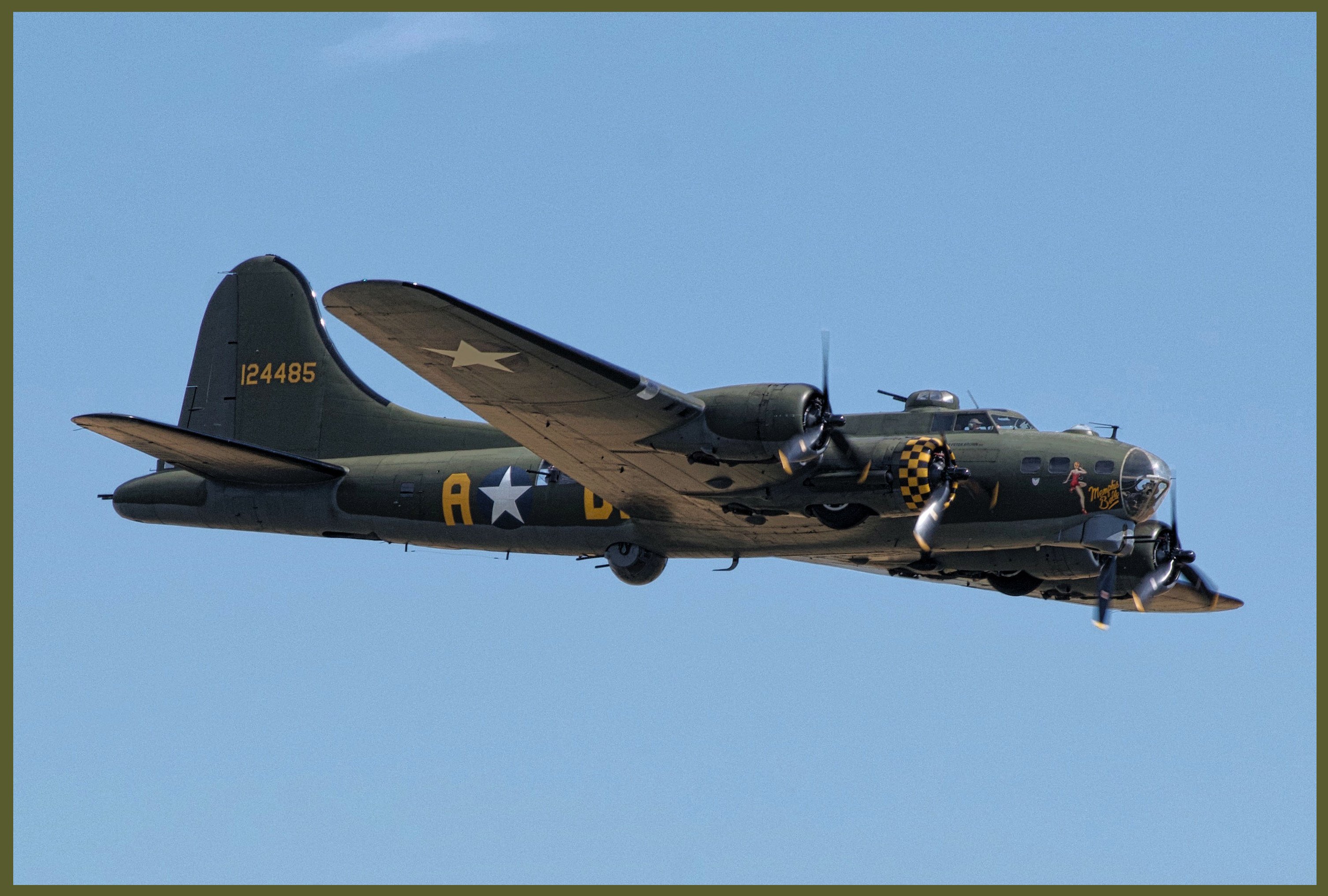
June 1942
RAF raids are intensified against German cities such as Hamburg, Berlin...
Consolidated B-24 Liberator
The USAAF took delivery of its first B-24As in mid-1941.
More B-24 Liberators were built than any other American aircraft! They carried more bombs further, and faster than the more famous B-17 bomber.
The B-24 Liberator was one of the two main types of bomber aircraft used by the USAAF to attack the Third Reich. It was made in huge numbers in American factories: 19,256 were built at five main locations.
On June 12th, 1942, 13 B-24s of the Halverson Project (HALPRO) flying form Egypt attacked the Axis-controlled oil fields and refineries around Ploiesti, Romania.
During the summer 1944, the Eighth Air Force had 78 B-24 squadrons in England! More B-24s flew from the U.K. than anywhere else in the world!
With its long range, the Liberator also played a key role with the US Navy and RAF Coastal Command against German U-boats in the Battle of the Atlantic.
Each bomber contained a team of people reliant on each other to complete their mission and to stay alive!
Pilot and Co-pilot: They of course controlled the plane take-off and landing. It’s only when they were over the target that they gave the control to the Bombardier. Why? So that he could make the adjustments needed to bomb accurately.
The pilot was also the plane’s Captain, in command of the plane and mission.
The co-pilot helped him fly the plane and was in control for portions of the flight. He was also ready to take over if the pilot was wounded or killed.
Bombardier: His position was at the nose of the plane and his job was to release the bombs accurately over the target, using the top-secret Norden bombsight. Over the target, he could control the movement of the aircraft from his position
Tail Gunner: He was generally able to inflict the most damage on enemy fighters, as his guns covered the most likely angle of attack.
Due to the position and angle of the guns, gunners had to kneel for most of the mission. Frostbite was an extremely serious hazard for all of the crew, the tail gun position was particularly vulnerable to the cold.
Radio Operator: His job was to communicate with home base and other aircraft. He was also responsible for photographing the bomb run to determine its effectiveness, as well as First Aid and manning a gun if necessary.
Waist Gunners: The two men stood in the middle or waist, of the aircraft. They spent the mission watching and waiting for enemy aircraft.
Waist gunners experienced the highest casualty rates among crew members. Why? They stood, meaning that their whole bodies were exposed. There was very little protection from the thin metal aircraft skin.
They would often take a pair of flak jackets with them, one to wear and one to stand on to provide a small amount of extra protection from flak bursting up through the floor.
Ball Turret Gunner: His job was to look out for enemy aircraft approaching from any direction! He could rotate 360° horizontally and up to 90° vertically.
Navigator: His job was to direct the airplane from departure to destination and back again. He needed a combination of good mathematical ability, navigational skill and concentration to maintain an accurate reckoning of the plane’s position at all times.
Every job in a B-17 or B-24 was carried out in a deafening and hostile environment.
Crews had to wear huge, electrically heated suits to fight the extreme cold, and oxygen masks to be able to breathe at high altitude.
They also wore helmets and body armor which offered a bit more protection against enemy bullets and shrapnel than the aircraft’s thin skin.
The young crewmen knew that the odds were against them. In the first year of operations, only 36% of heavy bomber airmen could pray to complete 25 missions, the number required before they could go home.
Often a crew was not made up of the same people using the same aircraft, the desperate odds meant that men who flew together often bonded closely, both during and after the war.
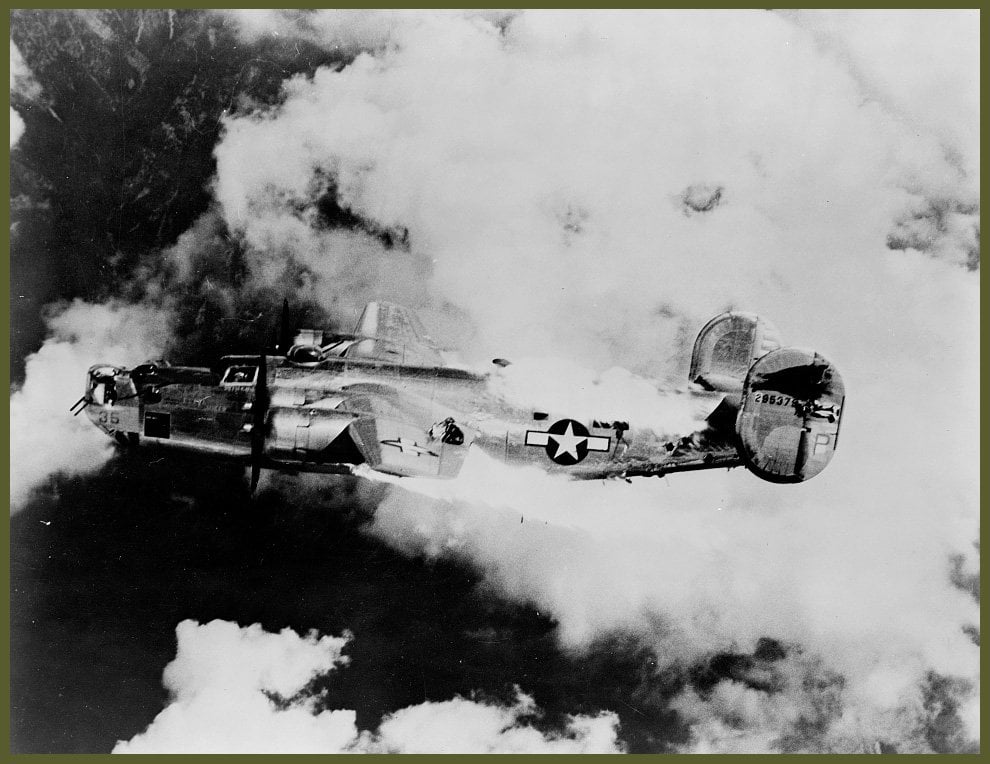
July 1942
July 4th, 1942 the USAAF airmen flew their first air raids with the RAF to attack four German fighter bases in occupied Holland.
By the time of the Normandy landings, June 6th, 1944, the German air force was decimated, and attacks targeting fuel facilities, like in Romania, dramatically eroded their capabilities for mechanized warfare.
American bombers joined the battle for the skies, as the air offensive escalated throughout Europe.
Continuous waves of heavy bomber attacked German military and industrial targets. Thousands of bombers and fighters bombed the Germans day and night.
Allies had an all record bombing, dropping 8,000 tons in just 36 hours! 200 tons an hour fell on the enemy territory. This sledgehammer blow smashed German resistance.
In time, the impact will be devastating to Germany’s cities and its air force.
Allied crews suffered heavy losses too, flying extremely dangerous missions over Nazi-occupied Europe. En route to bomb crucial factories in Schweinfurt, Germany, Staff Sergeant Winston Toomey of the 327th Bomber Squadron was mortally wounded when his B-17 encountered devastating anti-aircraft fire. Refusing to leave his post, he released his bombs, closed the bomb doors, and slumped over…dead. He survived just long enough to complete his mission.
Allied bombers flew around the clock, the RAF taking care of the German cities by night, the USAAF striking high-value targets by day.
Air supremacy was the crucial objective for the Allies wanted to win the war. If the Allies won the skies over the Third Reich, they could then hope to succeed in the amphibious invasion of D-Day in Normandy and liberate Europe from Nazi tyranny. At least that was the plan!
August 1942
August 17th, 1942, the first USAAF raid was done by American bombers against railroad marshalling yards at the train station of Rouen-Sotteville in France, while a further six aircraft flew a diversionary raid along the French coast.
September 1942
Hans-Joachim Marseille (13 December 1919 – 30 September 1942) was a German Luftwaffe fighter pilot and flying ace during World War II.
He is remembered for his aerial battles during the North African Campaign and his Bohemian lifestyle.
One of the most successful fighter pilots, he was nicknamed the "Star of Africa".
Hans-Joachim Marseille claimed all but seven of his 158 victories against the British Commonwealth's Desert Air Force over North Africa, flying his Messerschmitt Bf 109 fighter during his entire combat career.
No other Luftwaffe pilot claimed as many Western Allied aircraft as Marseille!
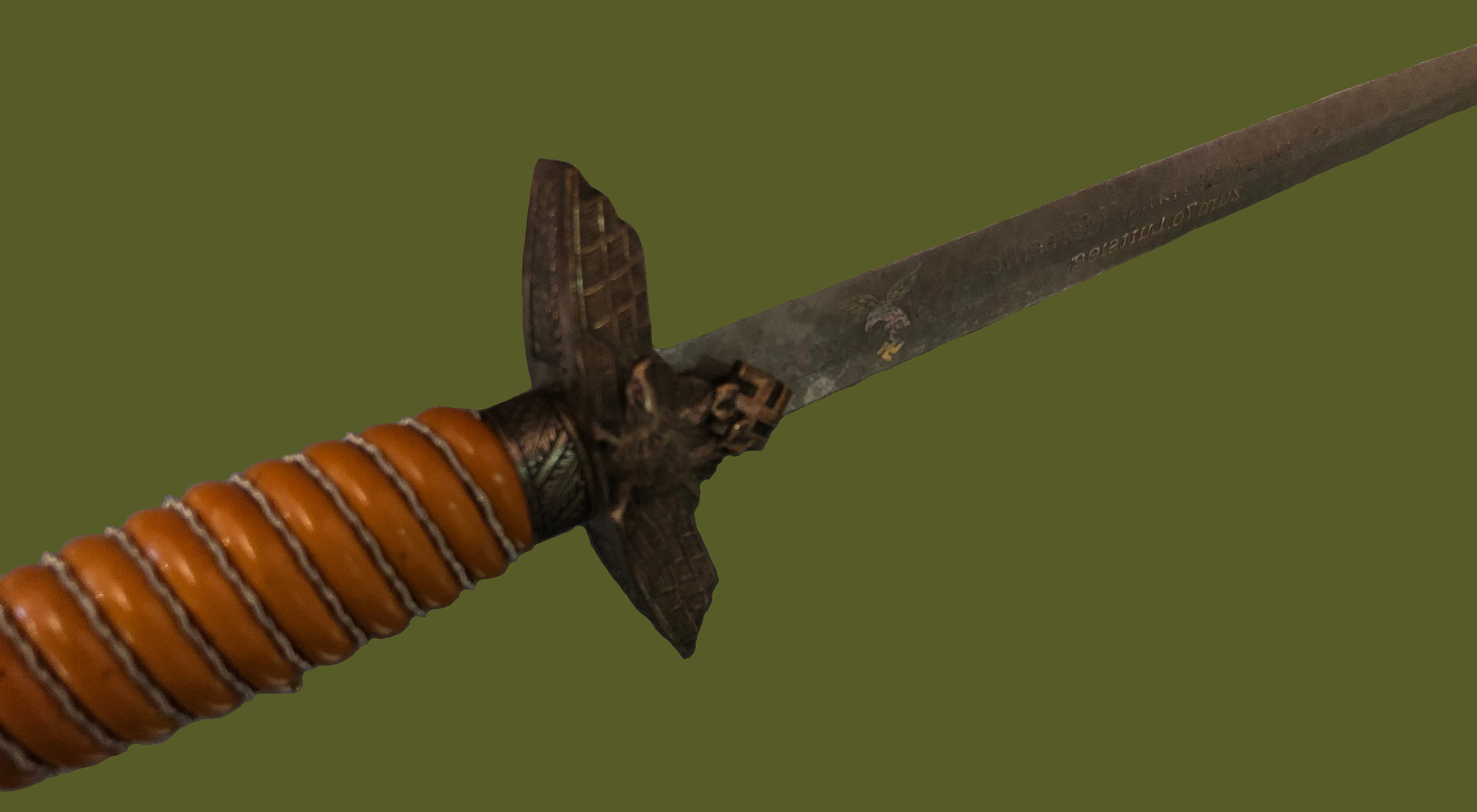
Commemorative dagger awarded to German flying ace Hans-Joachim Marseille
in recognition of his 70 air victories in North Africa
October 1942
While building its strength, the USAAF crews focus on closer targets, particularly the U-boat bases in Brittany of Brest, Saint-Nazaire and Lorient.
North American B-25J Mitchell
This bomber was used to attack targets on or near the front-line during WWII and arrived in Egypt to carry out independent operations there just before Operation Torch.
The B-25J Mitchell went into service with the USAAF in 1941.
Production of B-25s increased after the US entered WWII. In total 9,815 were built. It was named after General William “Billy” Mitchell, who in the 1920s had argued strongly that bombers were vital to success in war. A visionary in his time!
With a crew of six, it had twelve 0.50-inch machine guns with a maximum bomb load of 2,721 kg (6,000 lbs.). The combat range was 1,931 km (1,2000 miles) with 1,451 kg (3,200 lbs.) bomb load cruising at 370 km (230 mph). The top speed was 458 km (285 mph) at 3,695 meters (13,000 feet) once the bombs were dropped!
The plane first became famous when in April 1942, sixteen B-25s let by Colonel James Doolittle, flew from the aircraft carrier USS Hornet to make a daring raid on Tokyo, Japan.
After the Pearl Harbor attack, American and her Allies continued to suffer frustrating defeats against Japan in the Pacific.
A secret plan to bomb the Japanese capital using land-based Army B-25 bombers launched from a Navy aircraft carrier was developed to boost American morale and shake Japanese confidence.
Lieutenant Colonel “Jimmy” Doolittle trained volunteer Army aircrews to fly off the ship, find their targets and then continue on to friendly bases in China.
With the “Raiders” on board and their 16 B-25s tied to her flight deck, aircraft carrier USS Hornet and her task force left San Francisco for Japan on April 4th, 1942.
On April 18th, 1942, while still 200 miles from the planned launching point, the American fleet’s approach was radioed by a Japanese trawler before it could be sunk. Despite fuel concerns over the added distance, Doolittle led the Raiders in an immediate takeoff. All sixteen bombers individually flew on to strike at their targets in Tokyo and surrounding cities.
Undamaged by the Japanese defenses, but low on fuel, one B-25 successfully diverted to Vladivostok, Russia, while four ditched near the Japanese-held Chinese coast. Eleven were abandoned from the air further inland.
Three flyers were killed outright, eight were captured by the Japanese of which three were executed and one died in captivity.
The remaining 64 Raiders were helped to safety by the Chinese.
For his role, Jimmy Doolittle was promoted to Brigadier General and received the Medal of Honor. The Raiders each received the Distinguish Flying Cross.
The B-25 went on to become one of the most widely used aircraft of WWII, serving with the USAAF, Navy and Marine Corps, and were sent to the Soviet Union, Great Britain and China.
In the Mediterranean, B-25 Mitchells were used to support the troops on the ground as they fought through southern Europe. Many of these missions involved attacking bridges and other transport targets.
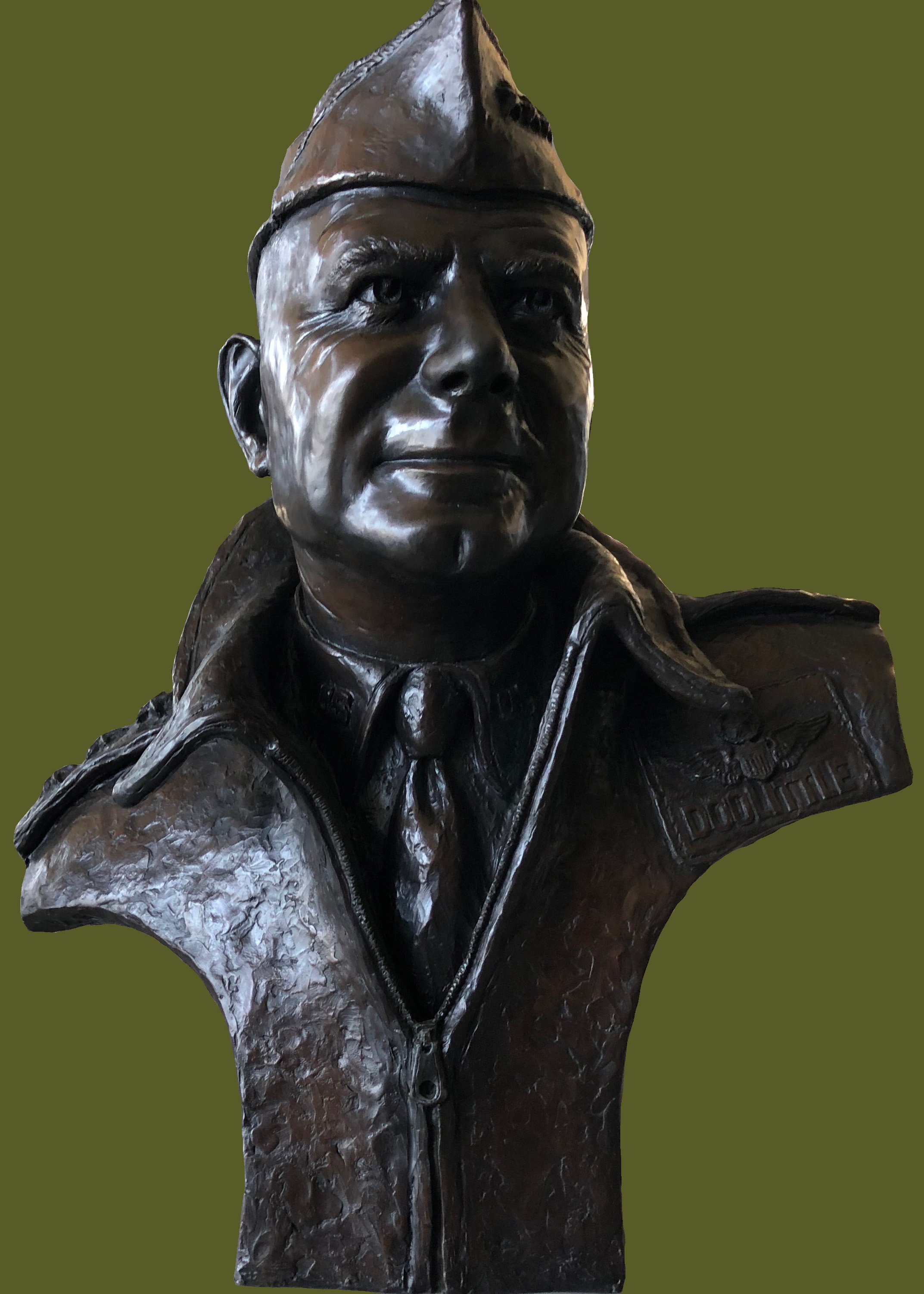
November 1942
November 8th, 1942, Operation Torch. The Allies launch the invasion of North Africa, the first important step to the liberation of Europe from Nazi tyranny.
December 1942
The Allies agree to a plan for the air war against the Third Reich. The objectives? Annihilate German industries and break the morale and/or fighting spirit of the Germans!
The RAF from now on will attack at night, the USAAF by day
Some British and American commanders believed that air power alone could defeat the Third Reich. Bombing could destroy an enemy’s industry, and its ability without the need for armies on the ground. This idea formed a key part of the Allies’ plans.
The RAF found that it was safest to bomb at night, when bombers could not be seen by defending fighter aircraft. Night-bombing was, however, less accurate. Britain focused its raids on large targets, particularly German cities. Why? This was where most factories were based.
When the US joined the war, the USAAF planned to bomb in daylight using their new, accurate Norden bombsight. They thought that this precise way of targeting bombs would allow them to succeed where the RAF could not. They also believed that their heavily armed bombers would be able to defend themselves against German fighter attacks but soon will realize they were wrong.
Both Britain and the US invested huge resources into the day and night bombing campaign. Thousands of bomber and fighter aircraft from many bases in Britain, were sent to targets across Europe almost every day. Maintaining support for this huge effort was vital.
The USAAF enlisted journalist and filmmakers to publicize the work its crews were doing.
William Wyler, born in Alsace-Lorraine moved to the US as a teenager.
During WWII he served in the USAAF and made films which showed Americans at home what the air war was like.
He flew on several missions to make “The Memphis Belle, a story of a Flying Fortress” (available on Netflix) which described the campaign through the story of one B-17 aircraft.
The message was clear. The air war was hard and dangerous, but crews could survive the terrible odds, while getting the job done.
It made heroes of its subjects. William Wyler lost the hearing in one ear while making a film about P-47 fighter-bombers in Italy titled “Thunderbolt”.
Later he will become an Oscar-winning film director of movies like the famous "Ben-Hur".
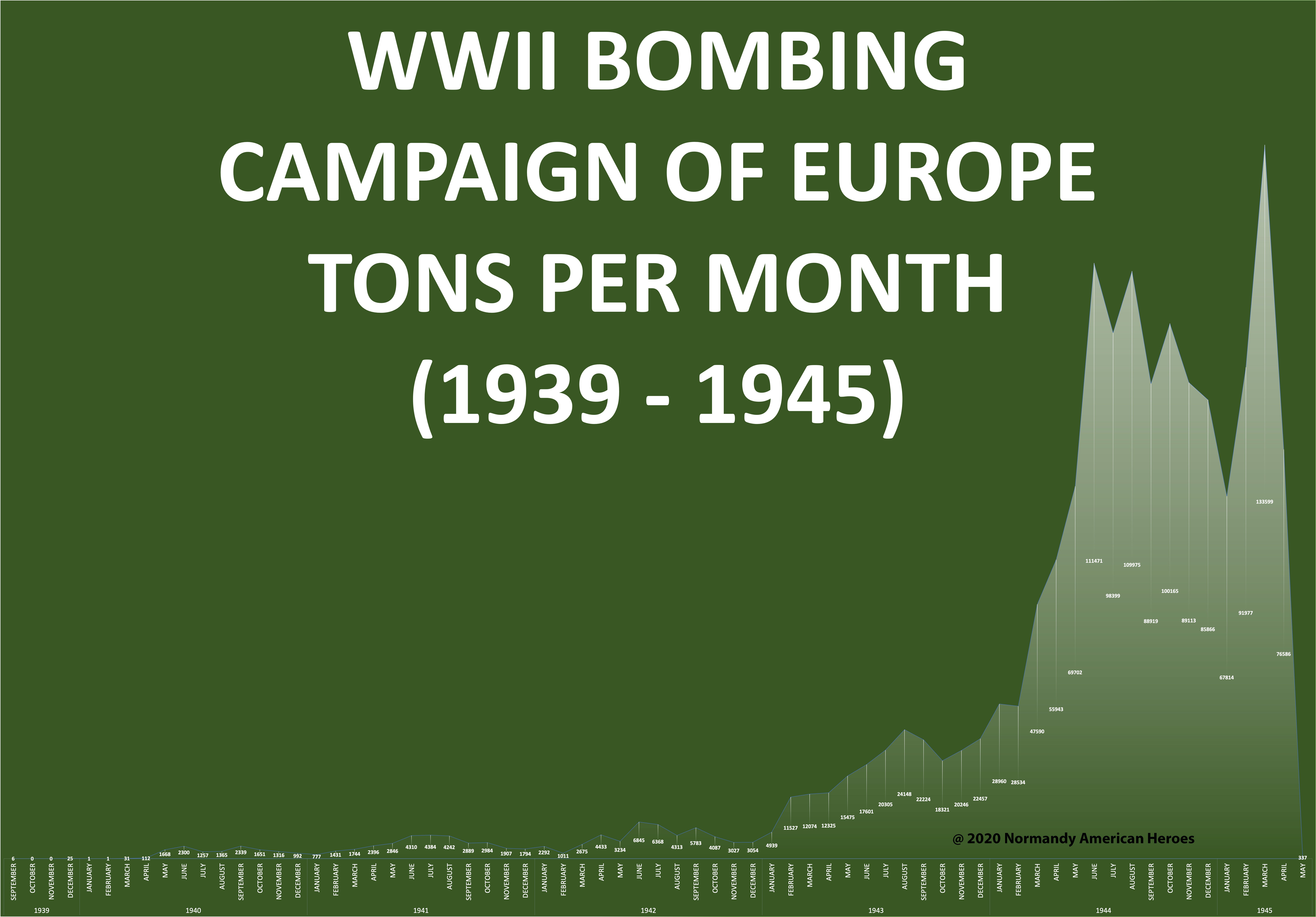
Approximately 48,000 tons will be dropped between January and December 1942

















